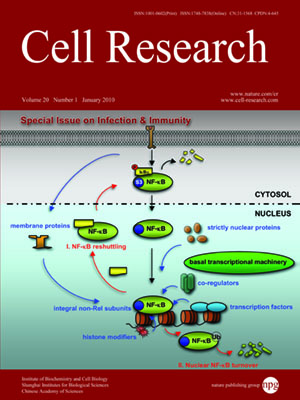
Volume 20, No 1, Jan 2010
ISSN: 1001-0602
EISSN: 1748-7838 2018
impact factor 17.848*
(Clarivate Analytics, 2019)
Volume 20 Issue 1, January 2010: 24-33
REVIEWS
The nuclear signaling of NF-κB: current knowledge, new insights, and future perspectives
Fengyi Wan and Michael J Lenardo
Laborathory of Immunology, National Institute of Allergy and Infectious Diseases, National Institutes of Health, Bethesda, MD 20892, USA
Correspondence: Fengyi Wan,(fwan@niaid.nih.gov)
The nuclear factor-kappa B (NF-κB) transcription factor plays a critical role in diverse cellular processes associated with proliferation, cell death, development, as well as innate and adaptive immune responses. NF-κB is normally sequestered in the cytoplasm by a family of inhibitory proteins known as inhibitors of NF-κB (IκBs). The signal pathways leading to the liberation and nuclear accumulation of NF-κB, which can be activated by a wide variety of stimuli, have been extensively studied in the past two decades. After gaining access to the nucleus, NF-κB must be actively regulated to execute its fundamental function as a transcription factor. Recent studies have highlighted the importance of nuclear signaling in the regulation of NF-κB transcriptional activity. A non-Rel subunit of NF-κB, ribosomal protein S3 (RPS3), and numerous other nuclear regulators of NF-κB, including Akirin, Nurr1, SIRT6, and others, have recently been identified, unveiling novel and exciting layers of regulatory specificity for NF-κB in the nucleus. Further insights into the nuclear events that govern NF-κB function will deepen our understanding of the elegant control of its transcriptional activity and better inform the potential rational design of therapeutics for NF-κB-associated diseases.
Cell Research (2010) 20:24-33. doi: 10.1038/cr.2009.137; published online 8 December 2009
FULL TEXT | PDF
Browse 2389


